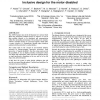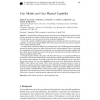1621 search results - page 49 / 325 » Designing Computer Interface for Physically Challenged Perso... |
AVI
2006
13 years 9 months ago
2006
The ASPICE project aims at the development of a system which allows the neuromotor disabled persons to improve or recover their mobility (directly or by emulation) and communicati...
FDG
2009
ACM
14 years 2 months ago
2009
ACM
Passengers pay attention to the landscape as they move through the environment. We suggest a new type of applications, which adds to that experience. It consider their motion and ...
CHI
2007
ACM
14 years 8 months ago
2007
ACM
In navigating large information spaces, previous work indicates potential advantages of physical navigation (moving eyes, head, body) over virtual navigation (zooming, panning, fl...
HUC
2005
Springer
14 years 1 months ago
2005
Springer
Abstract. The physical disappearance of the computer, associated with Ubicomp, has led to a number of interaction challenges. Due to the lack of an interface users are losing contr...
UMUAI
2002
13 years 7 months ago
2002
Current interface design practices are based on user models and descriptions derived almost exclusively from studies of able-bodied users (Keates et al., 1999). However, such users...


